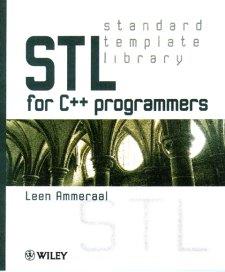
Although the primary focus is not Linux, his many excellent examples are easily adapted to the g++ environment in Linux 2.0++.

Author: Leen Ammeraal
Publisher: John Wiley
Price: $49.99
ISBN: 0-471-97181-2
Reviewer: Bob Adkins
Good news—STL, Standard Template Library, is alive and well on Linux. Leen Ammeraal demonstrates this as well as his considerable skills as a master teacher in STL for C++ Programmers. Although the primary focus is not Linux, his many excellent examples are easily adapted to the g++ environment in Linux 2.0++ (his examples adapted for Linux can be found at http://www.cwareco.com/download.html. Ammeraal writes concise yet thorough explanations on each aspect of using STL.
STL started in the 1970s with Alexander Stepanov's ideas about designing general algorithms. Stepanov, together with Meng Lee, took these ideas to HP and developed the first C++ based STL. By 1994, STL was accepted into the C++ draft standard by the ANSI/ISO C++ standards committee.
STL distinguishes general algorithms from the more specialized data and methods encapsulated by ordinary abstract data types. In this way, complex and powerful algorithms can be implemented independently of the data to which they are applied, allowing for generalization and reuse of these algorithms. In STL more familiar object abstraction is reserved for data and methods. These are then tailored and bound to the characteristics of their underlying container type such as sequence containers and associative containers. Examples of this distinction with respect to sequence containers, such as vector objects, are begin, end and insert. These methods access and manipulate the underlying data of the vector container class. However, these methods are specific to the treatment of the data and should not be confused with more general algorithms such as find, sort and other advanced numeric algorithms (e.g., accumulate or inner product). General algorithms are a kind of method abstraction in contrast to more traditional data abstraction.
STL support has been available on Linux since GNU's libg++ 2.6.2. Now with release 2.7.2.1, the library is quite usable for most major features with the exception of name space scoping. There are minor differences with other implementations, such as Borland's BC5 environment, but these differences mostly concern header naming conventions. There is also a curious problem with fstream which involves an unexpected file access mode default.
g++ 2.8.0 will offer a more complete STL based on newer code from SGI and a complete redesign of the compiler's template implementation. Unfortunately, g++ 2.8.0 is not expected to fix the problems with using name spaces.
From the beginning Leen Ammeraal presents a quick and practical startup for the STL beginner. He then explains how to use the sequence containers (vectors, lists and deques), the associative containers (sets and maps) and, later, examines containers derived from these basic types such as stacks, queues and priority queues. As a simple application, he shows how to to build a telephone directory using associative map containers. Later, he demonstrates a more complex map application, called a concordance, which produces a line-oriented index of all words in a text file. He also shows function objects which can be used to build custom ordering relationships among the elements of a container. He moves on to algorithms and the practical details of STL's generic algorithms for manipulating sequences and for sorting. He demonstrates the built-in numeric algorithms which make STL attractive for implementing statistical analysis such as the Least Squares Method.
As his final chapter, Ammeraal presents a wonderfully fun example of “Very Large Numbers”. Here Ammeraal uses STL to calculate pi to an arbitrarily large number of digits. Ammeraal exploits the power of STL to reduce the implementation complexities of defining and operating on extremely large numbers. He notes that, thanks to the STL's vector container, this version is “simpler and more elegant” than an earlier solution he presented in his book Algorithms and Data Structures in C++.
For added spice, I modified his program to generate a histogram of the digits computed for pi. At 100,000 places, digit “1” is a very slight favorite. Moreover, with this example Linux shows its strength. After turning on full g++ optimization, I was able to calculate these 100,000 digits in just under 20 minutes. Under DOS/Windows, Ammeraal indicated that this same calculation took several hours using BC5.